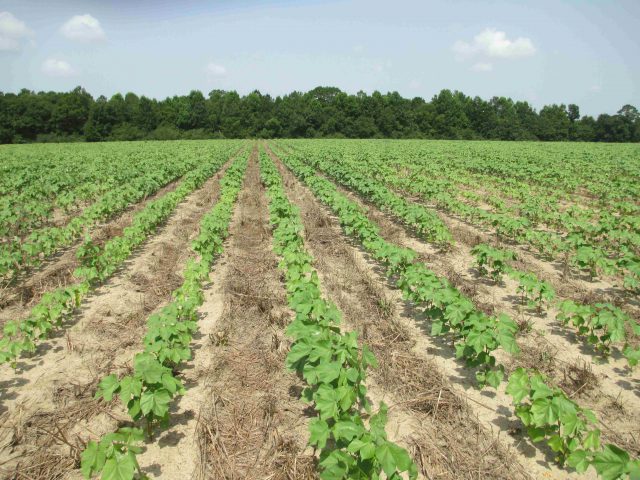
Florida farmers now can purchase both 2,4-D and dicamba resistant cotton and soybean seed, as well as the new low-volatility complimentary herbicides developed specifically for these varieties. Photo: Josh Thompson
Ethan Carter, Regional Crop IPM Agent, Jay Ferrell, and Ramon Leon, UF/IFAS Weed Specialists
Late last week, after much anticipation, the Florida Department of Agriculture and Consumer Services provided the final approval for use of 2,4-D and dicamba in resistant cotton and soybean cultivars. At time of publication, Florida has approved one 2,4-D product (Enlist Duo from Dow), and two dicamba products (XtendiMax from Monsanto and Engenia from BASF). Fexapan, a third dicamba product from Dupont has not yet been granted approval for use in the state of Florida.
Niether the 2,4-D nor dicamba products are restricted use products, but extreme care should be taken when applying these products as with all pesticides. If using these products, be cognizant of sensitive crops in the area and whether or not neighboring cotton fields are resistant to what you are applying. In Florida, use of all of these new products are governed not only by their product labels, but also the Organo-Auxin Herbicide Rule. Detailed records regarding application information are to be kept for two years, and include but are not limited to, wind speed at time of application, location of treated area, name of treated crop, and name of the product used. The state label and Organo-Auxin Herbicide Rule should be closely inspected before making any chemical applications. If language differs between the two, the application will be designated by whichever is most restrictive. For example, if the product label states a wind speed of 3-15 MPH downwind as acceptable, but the Organo-Auxin Herbicide Rule specifies 3-10 MPH, 10 MPH would be the maximum allowable wind speed. Special attention should be paid to determine buffer areas. The Organo-Auxin Herbidide Rule requires buffer areas that are considerably larger than those required in the federal label of these new herbicide products.
For the most updated and current list of approved nozzles and tank mix partners to be used with Enlist Duo, XtendiMax, and Engenia, routinely visit the XtendiMax™ Herbicide, Engenia Herbicide, and Enlist Duo Herbicide websites. It is important to note that use of any nozzle or tank mix product not specifically approved and listed on these websites would be considered a misuse.
Enlist Duo is a group 4 and 9 herbicide, labeled for weed control and use in Enlist corn, soybeans, and cotton. There are currently no other approved 2,4-D products for use on crops that are 2,4-D-tolerant. The table below, although not an exhaustive list, provides examples of 2,4-D-tolerant cotton varieties.
Table 1. Examples of 2,4-D-tolerant cotton varieties.
| Variety | Maturity | Plant Height |
| PHY 330 W3FE | Early | Medium-Tall |
| PHY 340 W3FE | Early | Medium-Tall |
| PHY 380 W3FE | Early-Mid | Medium-Tall |
| PHY 450 W3FE | Mid | Medium-Tall |
| PHY 460 W3FE | Mid | Tall |
| PHY 470 W3FE | Mid | Medium-Tall |
| PHY 490 W3FE | Mid | Medium-Tall |
W3FE = WideStrike® 3, Genuity® Roundup Ready® Flex, Enlist™
XtendiMax and Engenia are group 4 herbicides, both labeled for weed control and use in dicamba-tolerant cotton and soybeans. It is important that ammonium sulfate never be added to these product formulations, as it will convert them from low to high volatility. There are currently no other approved products for use on crops that are dicamba-tolerant. The tables below, although not exhaustive lists, provide examples of dicamba-tolerant cotton and soybeans varieties.
Table 2. Examples of dicamba-tolerant cotton varieties.
| Variety | Maturity | Plant Height |
| DP 1725 B2XF | Early-Mid | Medium |
| DP 1747NR B2XF | Mid-Full | Medium-Tall |
| DP 1646 B2XF | Mid-Full | Medium-Tall |
| DP 1639 B2XF | Mid | Medium-Tall |
| DP 1614 B2XF | Early | Medium |
| DP 1612 B2XF | Early | Medium |
| DP 1553 B2XF | Full | Medium-Tall |
| DP 1538 B2XF | Mid | Tall |
| DP 1522 B2XF | Early-Mid | Medium-Tall |
| DP 1518 B2XF | Early | Medium |
B2XF = Bollgard II® XtendFlex® cotton
Table 2. Examples of dicamba-tolerant soybean varieties.
| Variety | Trait | Maturity |
| AG40X6 | RR2X | 4 |
| AG42X6 | RR2X | 4.2 |
| AG44X6 | RR2X | 4.4 |
| AG46X6 | RR2X | 4.6 |
| AG49X6 | RR2X | 4.9 |
| AG53X6 | RR2X | 5.3 |
| AG54X6 | RR2X | 5.4 |
| AG55X7 | RR2X | 5.5 |
| AG59X7 | RR2X | 5.9 |
| AG69X6 | RR2X | 6.9 |
| AG72X7 | RR2X | 7.2 |
| AG75X6 | RR2X | 7.5 |
RR2X = Roundup Ready 2 Xtend™
For more information, refer to the following publication: Using Dicamba in Dicamba-Tolerant Crops, or contact your local industry representative, or your County Extension Agent.
- 2025 Peanut Field Day Recap & Speaker Handouts - August 29, 2025
- Peanut Foliar Diseases Exploding Across Florida - August 22, 2025
- Provisional Nitrogen Fertilization Recommendation for Florida Cotton for the 2025 Season - June 20, 2025
